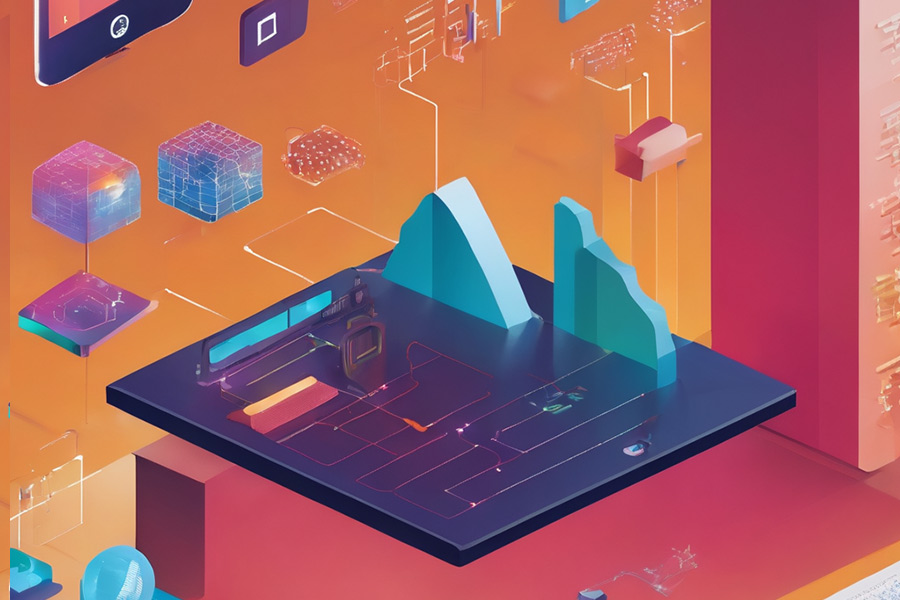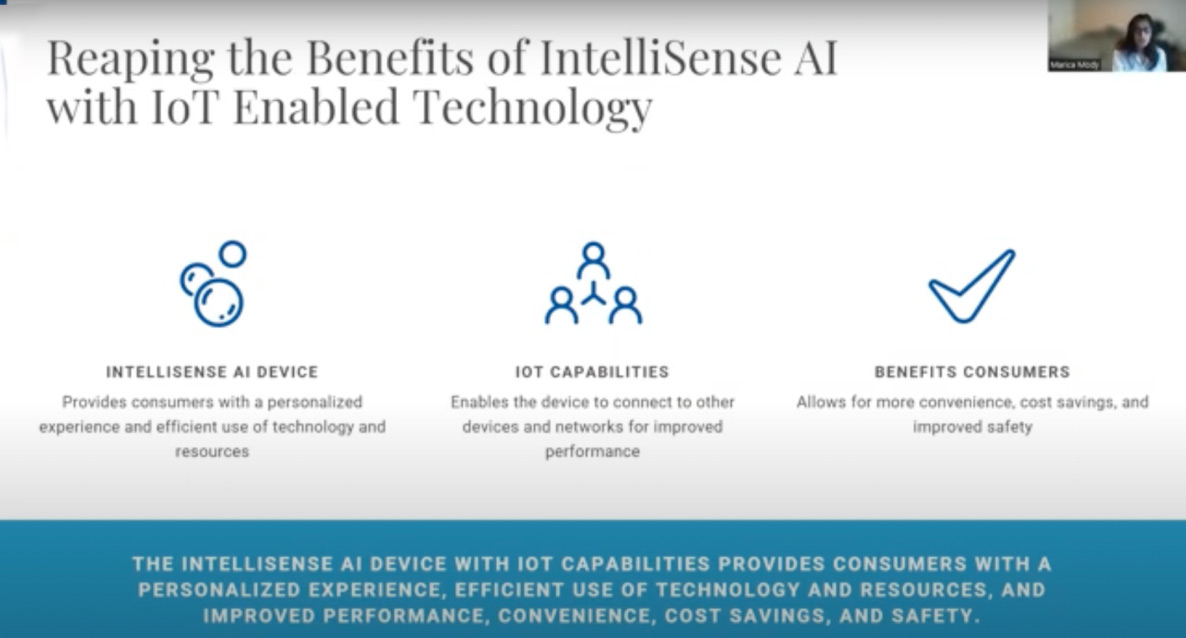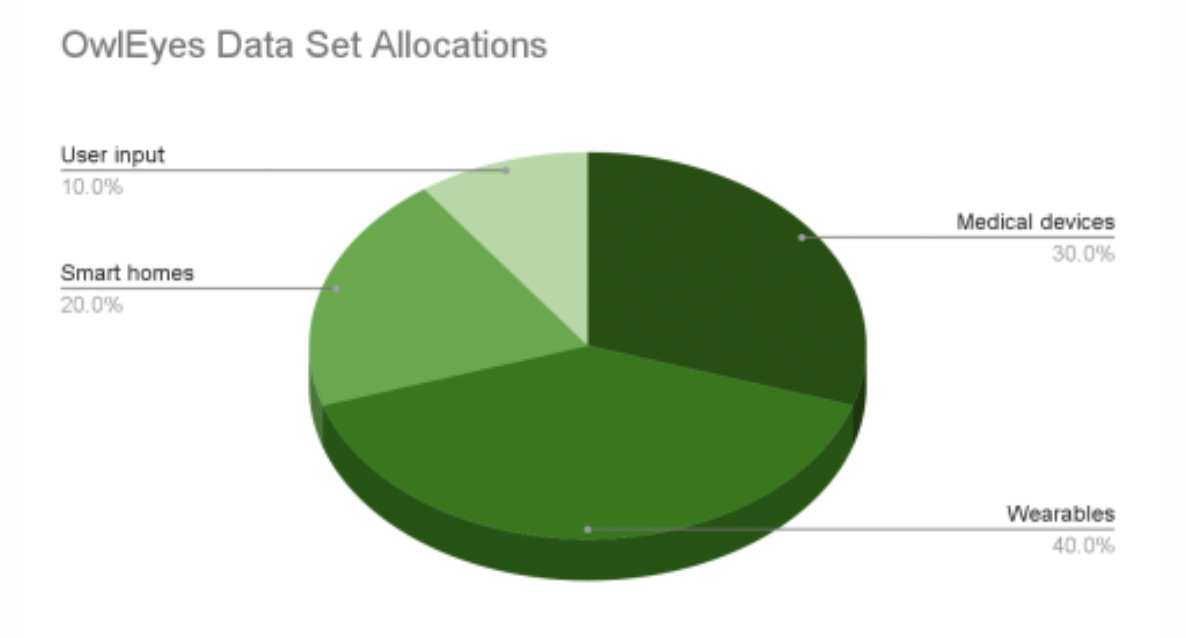
Designing AI and IoT Products: Cyber-Physical Product Design Final Projects
By Kaitlyn Stossel
The Cyber-Physical Product Design course is designed for students to learn the capabilities and limitations of current technologies such as AI, data science and interactive connected products. The course illustrates both the potential and current limitations of these techniques with examples from a variety of applications. Topics explored include awareness, real-time sensing and communication, embedded intelligence, and designing experiences for the Internet of Things (IoT). This course is part of the Technology for Product Managment certificate, which is designed to expose students to the science, tools, and techniques behind today's tech products.
Throughout the course this past Spring, Professor Arthur Sugden guided students to practice basic modeling and prototyping, and to complete a final project incorporating elements of connected products and smart systems.
“By the end of the course, there are two primary goals,” Professor Sugden said. “The first is to be able to guide a data team. Explicitly, to be able to consider any data science problem and select the optimal machine learning approach, considering both efficacy and expense.”
“The second is to create an AI and IoT product that we’d all love to buy. The final project is a series of interesting challenges built across the semester. A market opening, an interesting dataset, a machine learning model, the relative cost of parts, and finally a whole product.”
Explore student’s final projects below:
AI Chemical Manufacturing
IntelliSense
OwlEyes
AI Chemical Manufacturing
Marciano Bagnoli’s final project explored how generative AI could be used to automate the processes used in controlling chemical reactions and chemical production. The system would serve as a virtual assistant to monitor the reaction and double check any inputs to prevent manufacturing errors. It would serve as an additional layer of engineering controls for production safety, quality, and efficiency.
iii: What was the inspiration behind this project?
Bagnoli: It was a combination of things, really. I’ve worked in Manufacturing Quality departments in the Chemical Industry for several years, and knowledge governance is a challenge for most firms. The fact that different locations can have plants that were built at different times, with different levels of sophistication, adds additional complexity and idiosyncrasy of these processes. Managing this knowledge of how these processes function in an accessible way is critical for their success, but often it is held in the minds of experienced professionals. What happens when these folks retire or quit? How can we mitigate the knowledge loss for the organization during times of high turnover?
Another issue is the reliance on humans to govern and control these processes. We rely on our teams to make the best decisions each time, but mistakes do occur. While it can be tempting to point to things like training and accountability to fix the issue, the reality is that in order to truly improve operations you have to improve the systems in which they function. An AI system would allow the data from the manufacturing process and the decisions made to be tracked and trended in detail, provide digestible information regarding potential paths forward during manufacturing events, and be easily scaled and reproduced across sites as feasible.
iii: What have you learned from working on this project?
Bagnoli: The modeling of these reactions is actually fairly simple, and has been done before, the trick comes in how we bolt this technology onto an existing system in a commercial setting. Questions like: how do we know that we have encountered and modeled all potential process states? How many additional valves and processes need to be monitored electronically with a data stream into this algorithm? These considerations are crucial for business acceptance of the project. Additional safety and process integrity considerations show up as well. Where should this algorithm be hosted? If it is in the cloud, how can we ensure rapid response times, at all times? How can we ensure the algorithm can place the process in a safe state during a fire, tornado, or earthquake? While there were a lot of questions and considerations to balance, it allows a realistic and feasible roadmap to be developed to develop and deploy this technology.
iii: How do you see your project impacting the world of chemical engineering?
Bagnoli: The application of Artificial Intelligence into the Chemical Engineering space will be transformational, but it will be the firms that have already invested in sound engineering and data streams that will reap the first rewards of this transition. In some ways, the current winners may keep winning if they keep pace with the technological developments to the point of substituting AI systems for human workers. Many commodity chemical companies are chasing razor thin profit margins for bulk material, to the tune of a few cents per pound of material. If an AI system can help increase that margin and avoid any errors across hundreds of millions of pounds produced, the resulting profits will be pretty hard to ignore. Add the augmented safety and operational efficiency gains with that, the technology has the potential to be extremely disruptive. While AI has the potential to fundamentally change how humans work, it will be a disruptive shift. Large ice providing companies did their best to stymie early refrigeration and air conditioning companies, so too will organizations try to influence the application and development of AI in such a way that is in their interests. We should walk forward together with AI, and enable those whose lives are disrupted by it to contribute to society in a different way. History has shown us how dangerous a large group of disaffected individuals can be, and what they are capable of. AI can replace human tasks, but it should not replace our duty to respect the humanity of one another.
“Marciano quickly adapted his rigorous mathematical background into a deep understanding of data science,” said Sugden. “He integrated that together with his broad work experience and III coursework into a workable AI solution in his field. His product is thoughtful, valuable, and already ready to begin implementation.”
IntelliSense
Marica Mody designed IntelliSense to regulate energy consumption within households using AI. IntelliSense considers factors such as indoor and outdoor temperatures, carbon dioxide levels, humidity, lightning, rain, wind, and sun irradiance to provide a more detailed and accurate picture of the household’s energy usage compared to its competitors. Its comprehensive data set, compatibility with other IoT devices, and resilience in the event of a network failure make it a reliable and efficient way of managing energy consumption.
iii: How do you see IntelliSense impacting the energy industry in the future?
Mody: There are a number of impacts to the energy industry from this product.
IntelliSense is designed to optimize energy use within homes, reducing overall energy consumption. As more households adopt this technology, the demand on energy providers could decrease, leading to a decrease in energy production needs and therefore a reduction in greenhouse gas emissions.
- Demand Response Programs: With its ability to dynamically adjust energy use based on real-time conditions, the IntelliSense device when used in tandem with other household smart devices can play a significant role in demand response programs. These programs aim to adjust the demand for energy rather than adjusting the supply to create a balanced grid. This could be particularly beneficial during peak load periods, helping to avoid blackouts and reduce strain on the grid.
- Promotion of Renewable Energy: By using real-time data the IntelliSense device encourages the use of renewable energy sources. This could potentially lead to increased consumer interest in renewable energy solutions, pushing the energy industry to further invest in and develop renewable energy technologies.
- Smart Grid Compatibility: As our power grid evolves into a smart grid, this device can help households better integrate with modern systems. It could communicate with the smart grid, responding in real-time to changes in electricity prices or supply levels.
- Data for Energy Suppliers: The usage data gathered by the device can provide valuable insights to energy companies on consumption patterns, helping them better plan their energy production and distribution strategies.
- Consumer Awareness and Behavior Change: IntelliSense can also help users become more aware of their energy consumption habits and understand how their behavior impacts energy usage, potentially leading to more mindful usage and further energy conservation.
iii: What challenges did you face with this project?
Mody: There were a number of concerns which I faced when planning out this project.
- Consumer Adoption: Convincing consumers to adopt new technology can be a challenge, particularly if the benefits are not immediately apparent or require a significant initial investment. Additionally, this would work with other smart devices like Nest or Phillips bulbs, customer adaptation to fully smart homes can often be difficult.
- Integration with Existing Systems: IntelliSense needs to integrate smoothly with existing household systems and devices. If this integration is difficult or the system is not compatible with a wide range of devices, this could pose a significant barrier. The constant technological advancement now turns devices obsolete in a matter of years, leading to long term investment terms to ensure the system is running optimal.
- Privacy Concerns: Any system that collects data, particularly personal data like a household's energy use patterns, will need to carefully address privacy concerns. This includes both securing the data from potential breaches and being transparent with users about what data is collected and how it is used.
- Regulatory Compliance: The energy sector is heavily regulated, and any new technology introduced must comply with a wide range of regulations, which can differ by region.
- Reliability: The system needs to be extremely reliable. Any significant downtime or malfunction could not only disrupt people's lives but also make them less likely to trust the system in the future.
- Understanding User Behavior: The system's ability to effectively optimize energy usage is largely dependent on accurately predicting user behavior. If the system's predictions are often incorrect, this could lead to suboptimal performance and user dissatisfaction.
- Scalability: The system must be designed in a way that can easily be scaled up. As more users adopt the system, the backend infrastructure must be able to handle the increased load.
- Cost: The cost of implementing such a system might be high, especially for the advanced technologies required. The system should be affordable to the consumer to encourage wide adoption, but still provide a return on investment for the manufacturer.

iii: What are your biggest takeaways from this class?
Mody: This was the first time I took an idea from a thought to a tangible solution on my own. I learned so much about the importance of research, in the early phases I found so many sources of data and numerous data sets where I could pull information from. Then I hit a wall, how do I take only what is needed to build an AI system? This is where I learned how important data is to developing technology. I took a step back and looked at the problem and found the data which would give me information as to why this is occurring. From here, I was able to begin to piece the project together and focus solely on customer needs and providing a long term energy solution for households. I learned how to use data to find solutions, rather than just regurgitate information. My biggest takeaway was how in-depth I took the coding portion of the course. I went in with no knowledge of python and basic HTML. Although this course was designed to teach us the concepts of AI and ML, I really enjoyed learning how to utilize the data sets to derive information, which would have taken me hours to parse through using R. I learned how simple it is to take an idea and turn it into something investors can get excited about. Being data oriented, learning python took data analysis to a whole new level for me and I am looking to continue building my knowledge of python and machine learning to make impacts in the future.
“Marica went above and beyond the goals of the course and taught herself to program,” Sugden said. “Built upon this experience, she designed a product with an AI component that can rapidly be brought to market. This focused design based on hands-on experience is an excellent example of quality product design.”
OwlEyes
For her final project, Madiha Irfan designed OwlEyes, an eye strain monitoring and posture tracking system powered by Convolutional Neural Networks (CNNs). Designed for office workers, students, and anyone who spends long hours in front of a screen, OwlEyes offers valuable insights and alerts to help users maintain optimal eye health and posture while reducing distractions that may arise from using multiple operating systems in a day.
iii: What are your future plans for OwlEyes?
Irfan: I really enjoyed completing the research portion for OwlEyes and then diving into the technical build of these smart glasses. I am a research lover so ideally I would continue to do more research on what problem OwlEyes is solving for users. To me, what good looks like is when OwlEyes can become an effortless experience for customers in their daily use. I think sparking joy is important too, but becoming integral to a person’s routine without causing a burden in their routines is the most important. To get there, I would love to 3D print the classes and test them out live with working professionals.
iii: Can you explain the research process and how you came to understand the needs of your target audience?
Irfan: In my professional role, I follow the double-diamond theory. I used this same way of working with OwlEyes. I started with the discovery phase, where I am doing a competitive analysis, market sizing, and persona building. If I had more time, I would have liked to have done a stakeholder ecology. I then worked on the define stage, where I worked on the journey map of how this concept would be used and what their requirements would be. This helped me with the design and concept validation. Finally, I worked on the prototypes and how I would complete the user research (3D printing and testing with users if I had more time and budget). 
iii: What are your biggest takeaways from this project? What skills will you take away?
Irfan: The most surprising thing was that I became genuinely interested in learning to code. I want to thank Professor Arthur Sugden for making this topic approachable and supporting me every step of the way. If he hadn’t constantly pointed out the things I was doing right, like the business case, the research, and putting our lessons into practice, I would have just focused on what I was doing wrong. For me, the biggest takeaway is that there is a genuine need for diverse resources to give their perspective on when we build products like hardware and software.
“Madiha used her life experiences to identify a large unmet need in the market,” Sugden said. “She was willing to be creative to address an exceptionally difficult problem from both the AI and IoT space, but designed a product that others would like to buy. She is clever enough to have already adapted some of the ideas from the course into possible future ventures.”
“Already, we’ve had two products continue outside of class into possible startups,” Professor Sugden said. “In my mind, there is no greater success than a course that is interesting enough to be a jumping off point to bigger things. I consider it an honor to be amongst this fantastic group of people, all considering the most interesting and difficult parts of AI in the context of product design.”




